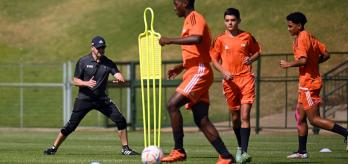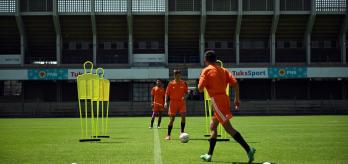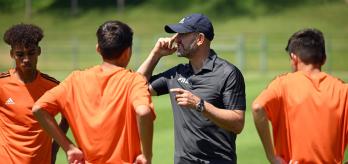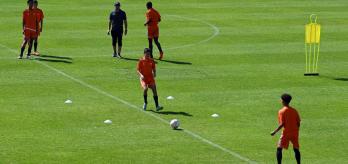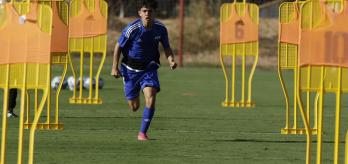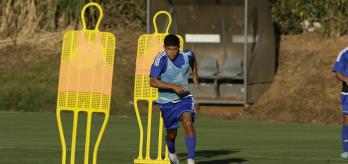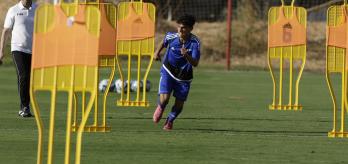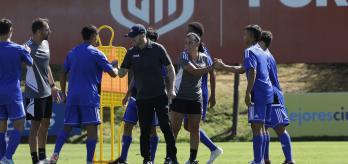For the five drills featured in part II, the standard work time is 30 seconds of high intensity followed by a one-minute recovery period. This work-to-rest ratio of 1:2 can be reduced to 1:1, as players become conditioned to the constantly high levels of energy demanded by footballing simulations at higher tempos.
Training perspective
Functional endurance part II is appropriate as a one-off session for players following a short-term injury lay-off (i.e. two to three weeks) or for repeated bouts of work to help rebuild functional anaerobic/aerobic capacity for players who have been sidelined for an extended period. The individual drills are six to eight minutes long and designed for two or three players assisted by one ball-serving player or coach. However, if there is only one player available to participate, then three ball servers are required to fulfil the training requirements of the drills.
Emphasis and methodology
In functional endurance part II, the principles of collective connectivity between a unit of players, as seen in part I, are also applied, with drills imposing a variety of pass-and-move interactions (with an emphasis on attacking patterns) within spaces of 30-50m2 and a passing range of 10-30m. The focus is on maintaining a fast rhythm and fluid technique to achieve the overall intensity objectives while varying the tempo to replicate the stop-start nature of technical interactions in a match.
Players work continuously during the repeated rotational sequences, with a work-to-rest ratio of approximately 1:2, i.e. 30 seconds of work with a one-minute recovery in order to regulate the overall intensity within a target range of 80-90% of their maximum heart rate. As players progress, a 1:1 work-to-rest ratio can be applied, elevating the intensity to maximal working capacity ranges up to 85-95%. The methodology places a loaded technical exposure on the players at an intensity that is appropriate for this phase of returning from injury. In addition, the drills are technically balanced, and good footballing awareness habits are encouraged.
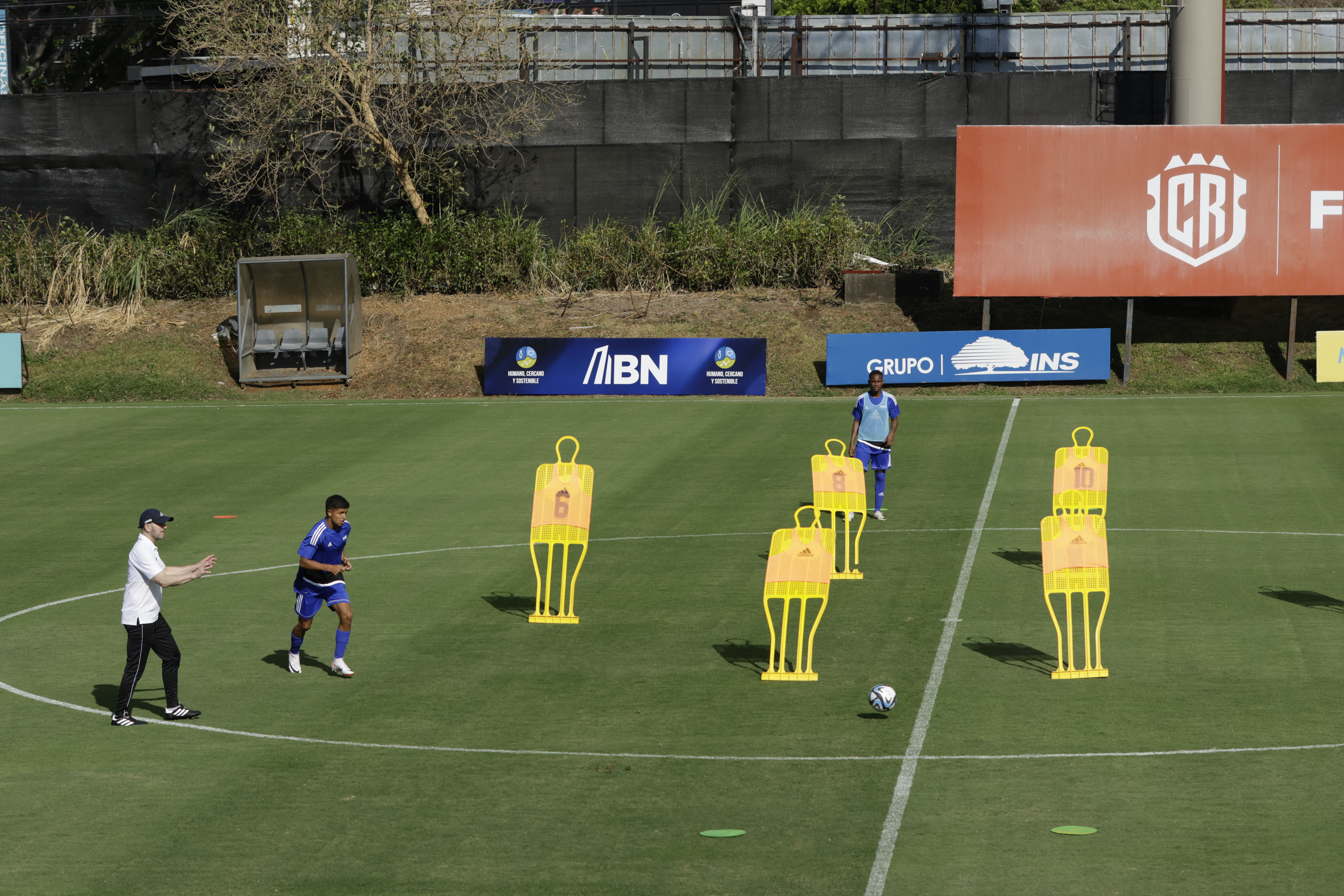
Overall objective
The goal is to provide functional training focused on anaerobic/aerobic endurance and a technical or physical stepping stone to the next transitional phase of returning from injury following a brief lay-off, or as a rebuilding phase following a longer spell on the sidelines.
Implementation
Aimed at all on-the-field practitioners responsible for helping players return from injury, the drills in this session form part of an overall training programme to provide a variety of technical-physical training solutions (with a particular emphasis on the technical elements) for all phases of recuperation. Practitioners can select individual drills or entire sessions to fit their overall training plans for players in their care.
The drills in this session can be used for:
- small training groups of 3-5 players;
NB: If using more than three players, a short out-and-back recovery shuttle run should be implemented for each player after they complete each drill rotation. For example, four players 10m shuttle, five players 20m shuttle, tempo 4-5mps - technical recovery sessions from high-intensity workloads or match play (minimum six players, maximum seven players);
- dedicated non-contact technique and passing quality; and
- technical-physical potentiation and warm-up.
Workload metrics
A simple table showing the duration of the drills, the number of sets, the work-to-rest ratios and guidelines for combining phase 1 and 2 drills can be found here:


Set-up for drills 1 to 3
Grid distances
-
Set up a 20x26m outer grid using flat discs or cones (a+b).
-
Set up a 10x10m inner grid using mannequins or poles (c+d) at the midpoint of the outer grid.
-
Place two flat discs/cones at each end (f) 3m apart at the midpoint of (a).
-
If no poles or mannequins are available, a mix of cones and discs may be used.
-
All drills require a server.
-
All drills are technically balanced, providing the opportunity to use both feet in equal measure.
-
The drills should start after a short period of familiarisation with the types of movement and relevant scenarios.
-
Encourage the players to maintain a good passing rhythm and tempo throughout the drills.
-
Encourage the players to change positions quickly during the technical interactions.
-
Periodically emphasise and encourage technical balance and reinforce awareness habits.
-
The drill durations are with the ball in play. Stop the watch if the drill rhythm is interrupted for more than a few seconds.
NB: For all drills, one player can work in isolation with two support players and one server for the specified out-and-back rotations or repetitions, and work-to-rest ratio. Alternatively, three players (and one server) can work in a continuous rotational loop alternating between each player after each specified work period of out-and-back rotations.
Drill 1: Turn and play forwards, turn and play diagonally
-
The support player from one corner of the grid starts the rotation with a pass played diagonally to the working player.
-
After receiving the ball, the working player drives between the mannequin gates and slots a straight pass to the server, before quickly moving wide to receive the return ball.
-
After shifting the ball beyond the wide mannequins, the working player strokes it out wide to the support player at the opposite side of the grid.
-
Finally, the working player sprints back towards the starting position ready to commence the first of two further out-and-back rotations.
NB: each out-and-back rotation should alternate with each rotation ending at the support players at opposite sides of the grid.
-
For technical balance, the working player should be encouraged to use their left foot when playing the left-to-right diagonal pass to the support player. Likewise, the working player should be encouraged to use their right foot when playing the right-to-left diagonal pass.
-
To reinforce good awareness habits, the working player should be encouraged to scan towards the support player before receiving the pass from the server.
Drill 2: Double-switch play with two continuous out-and-back rotations
-
The support player from one corner of the grid starts the sequence with a pass played diagonally to the working player.
-
The working player opens up and switches the ball out with a pass to the server positioned centrally on the other side of the grid, then holds their position to receive the return ball.
-
After then driving between the mannequin gates, the working player slots a diagonal pass to the support player at the opposite corner of the grid, and continues sprinting forwards through the mannequin gate to receive the return ball.
-
This sequence is then repeated on the way back to the original starting position.
-
One more continuous out-and-back rotation is then performed in the same manner.
-
For technical balance, the working player should be encouraged to use their left foot when switching the ball from right to left to the server. Likewise, the working player should be encouraged to use their right foot when switching the ball from left to right.
-
To reinforce good awareness habits, the working player should be encouraged to scan towards the server before receiving the pass from the support players and to get their head up before playing the ball to the support players.
Drill 3: Make a run behind, move into space, turn and play forwards
-
The support player shifts the ball forwards by passing diagonally across the inner grid to meet the working player’s run beyond the wide mannequin.
-
After receiving the ball, the working player plays an angled one-two with the server at the opposite end of the grid.
-
After diverting their run across the mannequin gates for the return ball, the working player drives forwards and strokes a diagonal pass out to the support player at the opposite corner of the grid.
-
Finally, the working player runs towards the starting mannequin gates to perform the second of three out-and-back rotations.
NB: The working player’s runs beyond the wide mannequin gates should alternate between the left and the right side of the grid.
-
For technical balance, the working player should be encouraged to use their left foot when playing the left-to-right one-two sequence with the server. Likewise, the working player should be encouraged to use their right foot when playing from right to left.
-
Furthermore, the working player should be encouraged to use their left foot to shift the ball forwards beyond the mannequin gate when receiving the ball on the left side from the server. Likewise, the working player should be encouraged to use their right foot to shift the ball forwards beyond the mannequin gate when receiving the ball on the right side.
-
To reinforce good awareness habits, the working player should be encouraged to scan towards the support player before making the short run beyond the mannequin gates and to get their head up before playing the ball to the support players at opposite corners.
Set-up for drills 4 and 5
Grid distances
-
Set up a 30x30m outer grid using flat discs or cones (a+b).
-
Set up a grid with three sets of mannequin gates placed centrally along the outer grid’s vertical lines, with 15m between each gate (c) and 4-5m between each gate’s mannequins (d).
-
Place two flat discs or cones in line with the mannequin gates at each end 7.5m away from the outer grid (e) and 4-5m apart.
-
Place two mannequin gates 30m apart vertically at the midpoint of the outer grid (f).
NB: If no mannequins or poles are available, cones or discs can be used instead.
Drill 4: Give and go, drive forwards to meet the return ball with a first-time pass-and-move combination
-
The working player drives between the first set of mannequin gates, then plays the ball out to the server. This is followed by a sprint beyond the centre gates to meet the return ball, then a straight pass to the support player beyond the final set of mannequin gates.
-
The working player then moves wide of the mannequins to receive a return pass.
-
Finally, after a second one-two pass-and-move with the support player, the ball is slotted between the gates for the working player to come away with it ready to repeat the second repetition of the out-back-out rotational sequence.
-
For technical balance, the working player should be encouraged to use first-time passes whenever possible to speed up the sequence.
- To reinforce good awareness habits, the working player should be encouraged to scan towards the server before receiving the second pass from the support players and to get their head up before playing the ball to the support players
Drill 5: Turn out and play wide, drive through the centre with the return ball
-
The working player turns out and plays the ball to the server, then runs beyond the first mannequin gate to receive the return ball.
-
The working player then sprints between the central mannequin gate and plays a straight pass to the support player at the opposite end of the grid.
-
After running beyond the last mannequin gate to receive a return pass from the support player, the working player turns out with the ball wide of the gates to commence the second repetition of the out-back-out rotational sequence.
-
For technical balance, the working player should be encouraged to use their left foot when playing the pass to the server on the left. Likewise, the working player should be encouraged to use their right foot when playing to the server on the right.
-
To reinforce good awareness habits, the working player should be encouraged to scan towards the server before receiving the pass from the support players and to get their head up before playing the ball to the server or support players.










